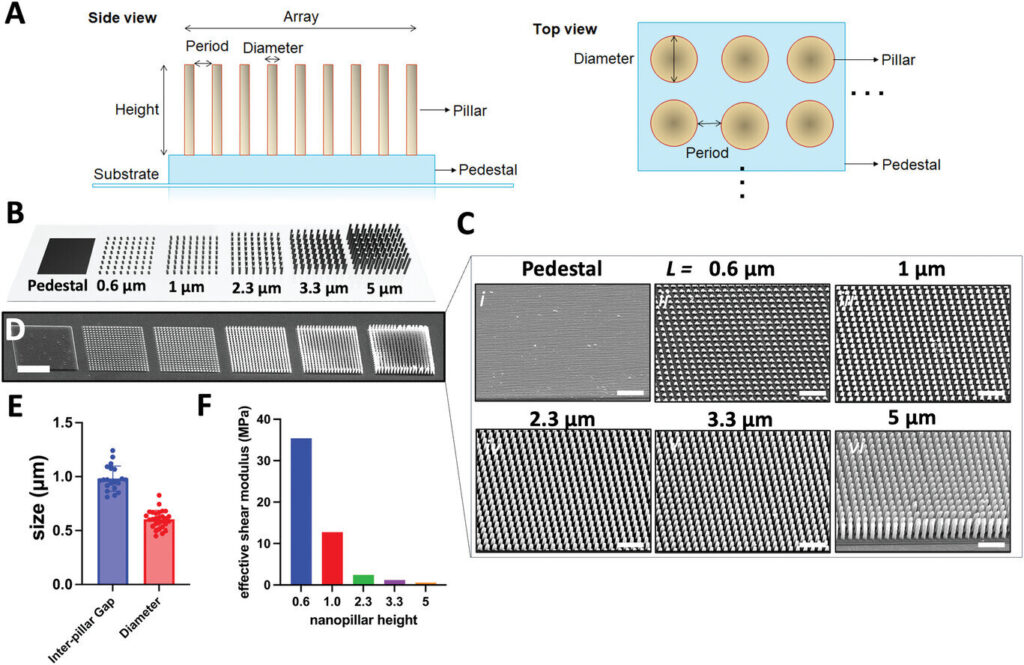Key cells in the brain, neurons, form networks by exchanging signals, enabling the brain to learn and adapt at incredible speed. Researchers at the Delft University of Technology in The Netherlands (TU Delft) have developed a 3D-printed brain-like environment where neurons grow similarly to a real brain.
Using tiny nanopillars, they mimic the soft neural tissue and the brain extracellular matrix fibers. This model provides new insights into how neurons form networks, as well as a novel tool to understand in future how this process may change in neurological disorders such as Alzheimer’s, Parkinson’s disease, and autism spectrum disorders.
The work is published in the journal Advanced Functional Materials.
Neurons, like many cells in the body, respond to the stiffness and geometry of their surroundings. Traditional petri dishes are flat and rigid, unlike the soft, fibrous extra-cellular matrix environment of the brain. To resemble the geometric and mechanical properties of this environment, the team of associate professor Angelo Accardo designed nanopillar arrays using two-photon polymerization, a 3D laser-assisted printing technique with nanoscale precision.
These pillars, each of which is a thousand times thinner than a human hair, are arranged like tiny forests on a surface. By changing the width and height (aspect ratio) of the pillars, the researchers tuned their effective shear modulus, a mechanical property sensed by cells when crawling on top of micro- or nano-structures’ arrays.
“This tricks the neurons into ‘thinking’ that they are in a soft, brain-like environment, even though the nanopillars’ material itself is stiff. While bending under the crawling of neurons, the nanopillars not only simulate the softness of brain tissue but also provide a 3D nanometric structure that neurons can grab onto, much like the extra-cellular matrix nano-fibers in real brain tissue,” says Accardo. This influences how the neurons grow and connect with each other.
From random growth to ordered networks
To test the model, the researchers grew three different types of neuronal cells, derived either from mouse brain tissue or from human stem cells, on the nanopillars. In traditional flat petri dishes and 2D biomaterials, neurons grew in random directions. But on the 3D-printed nanopillar arrays, all three cell types grew in more organized patterns, forming networks at specific angles.
The study also revealed new insights into neuronal growth cones.
Accardo notes, “These hand-like structures guide the tips of growing neurons as they search for new connections. On flat surfaces, the growth cones spread out and remain relatively flat. But on the nanopillar arrays, the growth cones sent out long, finger-like projections, exploring their surroundings in all directions—not just along a flat plane but also in the 3D space, resembling what happens in a real brain environment.”
“In addition, we found that the environment created by the nanopillars also seemed to encourage neurons to mature,” highlights George Flamourakis, first author of the study. Neural progenitor cells grown on the pillars showed higher levels of a marker of mature neurons, compared to those grown on flat surfaces.
“This shows that the system not only influences the direction of growth but also promotes neuronal maturation,” adds Flamourakis.
A tool for studying brain disorders
However, if softness is so important, why not just grow neurons on soft materials like gels?
“The problem is that gel matrices, like collagen or Matrigel, typically suffer from batch-to-batch variability and do not feature rationally designed geometric features. The nanopillar arrays model offers the best of both worlds: It behaves like a soft environment with nanometric features, and holds extremely high reproducibility thanks to the resolution of two-photon polymerization,” explains Accardo.
By better replicating how neurons grow and connect, the developed model could offer new insights into the differences between healthy brain networks and those associated with neurological disorders, such as Alzheimer’s, Parkinson’s disease and autism spectrum disorders.


